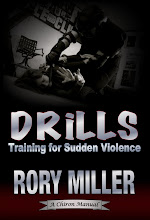Realistically, this feels like a new area. Most teaching methods are traditional, in the sense that they were handed down instead of purpose built. Most are centered around a school paradigm, with a high status instructor and low status students. And most assume that a problem is a problem, that in some way getting skilled at force is like getting skilled at math or engineering or medicine. But there aren't a lot of fields where you have to make quick, accurate decisions with partial information under an adrenaline dump. And in those fields, the most important part of instruction doesn't necessarily come in the class or at the academy-- things are set up very carefully to ensure that the first real encounters don't happen alone. Officers get an FTO. Paramedics work with a partner. Soldiers get assigned to a squad. Civilian self-defense doesn't have the modeling aspect that is so important to adjusting from training to application.
And I don't know the answer either. I have a collection of really important pieces. But a collection of pieces, as a writing project, looks like a mess.
The things I want to cover:
- The problem, as outlined above-- training for high stakes, low information, low margin of error rapidly evolving situations.
- Time in emergencies. Discretionary time, time distortion, stuff like that.
- Evaluating sources. Why social sciences are mistrusted in professional violence fields.
- Qualities of effective emergency techniques
- Teaching, training, conditioning and play. Definitions, values and drawbacks. This one is definitely the heart of the matter
- Scenario training
- Experience thresholds that rewire your brain and pitfalls and values of teaching from the different thresholds and how to handle teaching to people of different experience levels than your own.
- Dogma and it's effects. Tribalism versus truth
- Teaching adults/adult learning theory
- Big section on teaching professionals including designing lesson plans to standard, evaluation, getting lesson plans approved, required paperwork, coming in as an outsider...
- Testing effectiveness, evaluating "best practices"
- Related, the relationship between rules, policy and sympathetic magic. Ritualization of bureaucracy
- Working in the political reality (finding the line between effectiveness and policy and law; that the rules for how to teach are written around current models, not effectiveness)
- Bad student profiles and trouble shooting
- Designing short and long-term curricula
- Integrating skills (e.g. often, for police, DTs, handgun, baton, OC and Taser are taught in separate classes as separate skills.)
- Ethics and judgment under survival pressure
- Training and writing policy for Black Swan events
- Teaching homogenous versus diverse groups; diversity/homogeneity on different scales
- Related to above, possibly some advice for people who have never worked in certain environments. Some things that seem like attacks are actually tests, for instance.
- Explicit power dynamics
- Glitch hunting and countering social conditioning
- Managing a career as an instructor
- Questions, unknowns and twilight zone experiences for some of the sections.
It's a lot. It's loosely related, but feels like it's all over the place. This is the list of things I think I can write about with some value... grrrr. It just looks like a disorganized mess. A shotgun blast of data.
But the first rule of writing is to finish the damn thing. I can organize when the pieces are all done.


